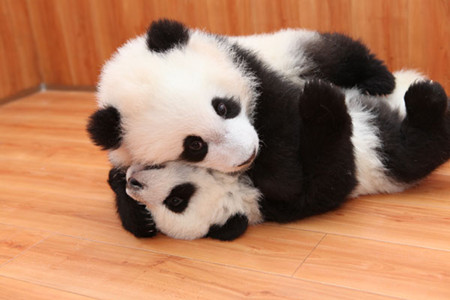
Among all the fields of international research on giant pandas, breeding is the most prominent, experts said.
Since cooperative research started in 1994, the Chengdu Research Base of Giant Panda Breeding has helped produce 13 cubs in Japan (11 survived), three in the United States and twins in Spain. The China Conservation and Research Center for the Giant Panda in Sichuan province contributed to the breeding of six cubs in the US, two in Austria and one in Thailand.
Any baby born to pandas on loan from China belongs to China, and the offspring are sent back at about age 4 to become part of the breeding population. So far, 11 of the pandas born overseas have returned.
In the process, the cooperative ventures have helped China raise its own level of animal breeding, feeding and research.
Different techniques
In 2006, Zoo Atlanta invited Hou Rong, director of a research center at Chengdu's research base, to the US in spring to help a pair of pandas breed via artificial insemination. The zoo had tried three times, unsuccessfully, to collect semen from Yang Yang.
A panda keeper later found that Yang Yang had a retrograde ejaculation problem. His semen was redirected to the urinary bladder rather than being ejaculated via the urethra. Hou suggested that semen be collected by electro-ejaculation combined with rectal massage.
A different procedure was suggested by another expert the zoo had invited - Richard Fayrer-Hosken, an animal reproductive medicine specialist with the University of Georgia's College of Veterinary Medicine. He insisted on first using a pipe to extract semen from the panda's urinary bladder and then washing urine off the sample.
After rounds of discussion, both experts succeeded in collecting sperm from Yang Yang in their own ways. But the quality of Hou's sample was considered better because the sperm had not been stained by urine.
The zoo used the fresh sperm sample collected by Hou to inseminate Lun Lun, who gave birth to Mei Lan on Sept 6, 2006. Mei Lan, whose name means "Atlanta's Beauty", returned to China in February 2010 and was appointed the global ambassador for Earth Hour, an event led by the WWF to fight climate change.
Hou used the same method in 2007 to help the Memphis Zoo in the US. The zoo had tried to collect sperm from a panda named Le Le five times but to no avail. When Hou succeeded, all staff workers on the scene burst into cheers and applause.
"After I was done," she said, "an American panda keeper followed me back to the laboratory. At that time, he didn't know I speak English and bowed to me deeply. I was so impressed."
Mothering lessons
Collecting sperm is not the only critical process. So is timing.
The female's estrus period comes just once a year, and she is receptive for only a few days. Therefore, it is crucial to seize the right moment and frequency of pairing, said Huang Zhi, animal management director of China Conservation and Research.
When mating succeeds, the job still may not be done. The center also has sent experienced staff members abroad to help female pandas raise their cubs. Some of the mothers do not do well because they have health problems, are inexperienced or can handle only one cub at a time (twins are not rare).
Chinese experts have taught their foreign colleagues how to bottle-feed and monitor cubs and how to feed the mother panda after delivery.

Copyright ©1999-2011 Chinanews.com. All rights reserved.
Reproduction in whole or in part without permission is prohibited.